This was published 3 years ago
Inside the Chi-Raq: gang members on ending the cycle of retaliation
By George Gittoes
My journey to Englewood in South Side, Chicago, began in Baghdad in 2003, when I was filming a scene for my documentary, Soundtrack to War, beside the palace pool of Uday Hussein, Saddam’s gangster son. I had come to record the poorest, mainly black, soldiers, sons of America, who found themselves billeted in the kind of luxury they had only ever seen in MTV music videos.
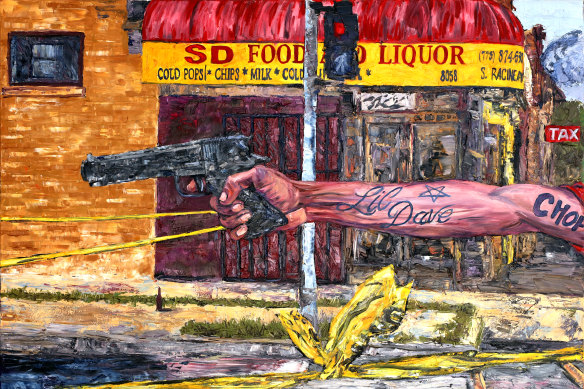
"Crime Scene" by artist and filmmaker George Gittoes.Credit: George Gittoes
A patrol had returned, totally wired with adrenaline, after surviving a fire-fight with the remnants of Iraq's Republican Guard. They invited me to film a rap freestyling battle in what they called the “bull ring”, saying they “needed to vent”. The two victors were Elliot Lovett, from Miami, and Ethiopian-born Yonas Hagos from Chicago. I felt protective of the genius of these urban poets and suggested I talk to their officers to see if they could be withdrawn from dangerous contact missions. Elliot laughed, saying “George, I joined the army because Baghdad is much safer than Brown Sub, Miami , where I come from.” Yonas sniggered and said: “But South Side Chicago is a real war zone. It makes Miami look like a play school for little kids.”
But it was not until 2018, when I heard that Englewood was now nicknamed Chi-Raq. I was shocked when Yonas sent me statistics showing there had been more gun deaths in this one Chicago neighbourhood, about the size of Wollongong or Bendigo, than of American soldiers killed in Iraq. Yonas challenged me: “George you have a duty to come and show the world what is happening to black people in a real war zone, in America!” I took him up on the challenge.
My company, Gittoes Films, is a team of three. Waqar Alam and myself do the day-to-day camera work and my wife, Hellen Rose, focuses on the music. Waqar is from the Tribal Belt of Pakistan and there is no one else I can trust with my life like I trust Waqar.
Yonas returned to Chicago from Iraq, seriously wounded but this did not stop him reinventing himself from an Ethiopian refugee who had escaped to Chicago to a multimillionaire American businessman. The American dream-come-true. He sent a limo to collect us from the airport, then put us in a four-star hotel. The next day, Yonas proudly showed us his magnificent home, in an upmarket white district, his exotic cars and gun collection. While Yonas was ecstatic to see us, it was clear his wife was not happy with the idea of him “risking it all back in the hood”. Privately, she told me: “It has been too hard for us to work our way out of the gutter to lose it all, now”. As I played with his two young children, I realised she was right; it would be wrong to take Yonas back.
Waqar and I pinpointed what was the worst corner (East 67th Street and Rhode) in Southside, with the highest number of murders and gang shootouts. We rented a car and went to the nearest Starbucks, to check out house rentals and, through a contact, found two ground floor apartments.
After being kept awake most of the first night, by constant police and ambulance sirens, I took a hot cup of tea down to the corner and sat on a log. I soon had curious locals sitting with me. I was a total oddity, the first white man they had seen in the neighbourhood that wasn’t a cop. The gang that usually sold drugs from the corner were all in jail and I had suddenly filled the void. I told these new friends about my film plans and asked, “Do you know someone who has been shot and nearly died from the wounds?” I had decided this was the best way into a film about gun deaths.
My new neighbours recommended someone they called “the prince of the streets”, Solja, who had lost a leg and been semi-paralysed by a hail of bullets while visiting the local store. Solja is the leader of the younger members, of the legendary gang the Black Stones.
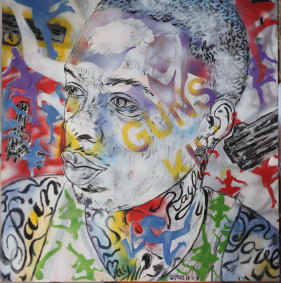
"Solja - Prince of the Streets" by George Gittoes.Credit: George Gittoes
When Waqar and I walked into Solja’s apartment, he looked up to us from his wheelchair, puzzled to see a long-haired, old, white man and a young Pakistani who, he assumed, would be ‘packing guns’. His followers reacted like cats putting their fur up and hissing through their teeth, as their hands reached for their actual guns. Since then those young men, Li'l Dave, Li'l Mac, Lolo, Head Shot, Boozie and Solja, have grown so close to me they treat me like their pop or adopted father.
People ask me “How did you get their trust ?” and expect me to say it took a long time but the reality is it was less than 3 minutes, and within 15 minutes we were filming interviews that were so frank I began to worry they were seriously incriminating themselves.
If you grow up black in the segregated ghettoes of America or are born into a war zone, like Afghanistan, you have to learn how to read someone in seconds; misjudging can cost you your life. Taking time to trust or not trust someone is a luxury. If an active war is raging, the assessment has to be lightning fast.
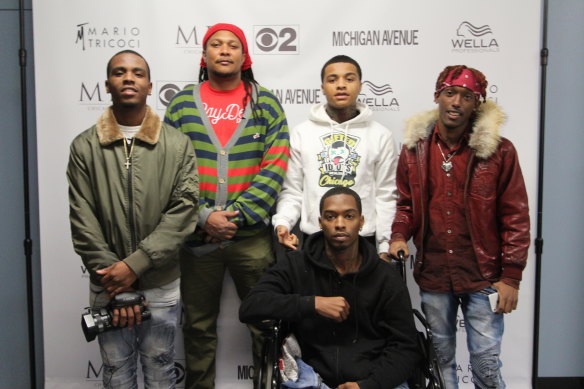
Members of the May Block community at the Mario Make Me a Model competition (from left) Jon Jon, Smiley, Li'l Mac, Li'l Dave and (front) Solja.Credit: Waqar Alam
I asked: “Who are these enemies who shot Solja and many of your friends?” Steven "Smiley" Armour, a respected elder in the area known as May Block, replied: “If you met them before you met us you would like them as much as you like us. There are no good guys or bad guys. It is just that if they do things to us, we have to retaliate, and no one can see a way out of this cycle of violence.”
The big revelation for us was that there was no need for one gang to slander or verbally criticise any other gang ... they all are caught in a cycle of violence they do not know how to end when the police do nothing to investigate shootings. They do not see each other as enemies but as victims of endless retaliation that needs to end.
There are no good guys or bad guys. It is just that if they do things to us, we have to retaliate.
Steven "Smiley" Armour , Community leader
I lived and worked in South Africa before the end of apartheid and the segregation was never as extreme in Soweto or Alexandra Township as it is in South Side Chicago. What makes this American version of apartheid work is the fear caused by the guns and killings. The red line that separates is no longer created by the racist manipulation of real estate as it was in the days of Dr Martin Luther King jnr, but the red, crime-scene tape, rolled out by cops, around countless killings.
We witnessed this, first-hand, when, after one night of hearing shooting we woke up to three separate crime scene areas taped off around our apartments. No one knows if it is a conspiracy to keep African Americans killing one another but it feels like one.
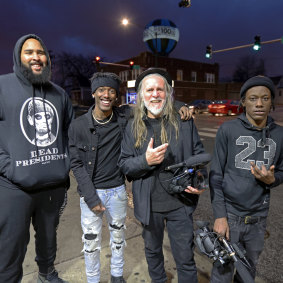
George Gittoes at work on the film in Chicago with (from left) artist Darius Marcus Ford, Li'l Dave and Boozie.Credit: Waqam Alam
Illegal guns are in oversupply and the cops do not investigate black-on-black murders. They arrest and intimidate for basic lifestyle offences but do not go after killers. It is not hard to meet community hitmen who have taken 12 to 16 lives and are still walking around. If they have done time it is for selling pot or traffic offences. No one talks to the cops; ‘snitches’ are despised. The one informant I met was promised total secrecy by the police, but it was only days before the news leaked out. That person now lives in perpetual fear, knowing someone will come for him, someday. Gun deaths in Chicago to June 22 this year, reported by the Chicago Tribune, total 1508 (350 more than in 2019). On May 31, 18 people were killed in 24 hours, the single most violent day in six decades of record-keeping.
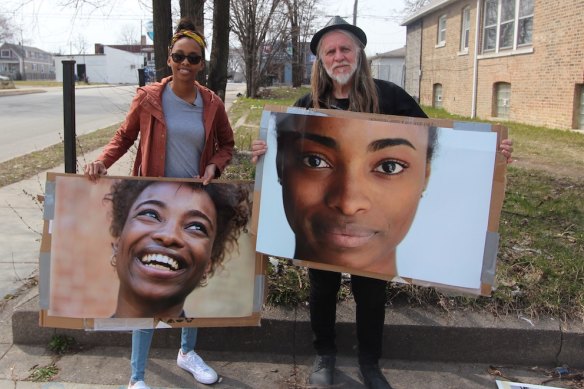
Filmmaker George Gittoes with Chantal Scott, whose sister Kaylyn Pryor (in posters) was murdered.Credit: Waqar Alam
There is a group of parents who have lost their children to gun violence who regularly protest because official statistics show only one in 10 murders on the South Side are solved. The "angel", of our film, is Kaylyn Pryor, who was famous for winning the Mario Make Me a Model Competition. The day Kaylyn was shot she was celebrating signing a contract with a big modelling agency, her ticket out. Even though Kaylyn was high-profile, there has been no success in finding her killers in the three years since her death.
While Waqar and I were out filming on the streets, my wife, Hellen Rose, was working with local musicians to create the White Light soundtrack and music album. Hellen was expecting a lively music scene from this home of Chess Records but was shocked to find live music is another homicide, mummified in crime scene tape and departed.
Sad twilight in birthplace of blues classics
Hellen: “South Side Chicago is the birthplace of some of the greatest jazz and blues ever exported to the world from the US. Mahalia Jackson, Cab Calloway, Muddy Waters, Howlin’ Wolf and Willie Dixon who wrote ‘Little Red Rooster’. It’s legendary Chess Records was where the Rolling Stones went to meet Muddy Waters in 1964; the area was a mecca for music lovers but it’s like a ghost town now. Without the guns it could be the equivalent of Beal St New Orleans or Soho London, with tourists and bars jumping with music. After a long search I found Soundmine, the last jazz recording studio in the area and had the honour of being the first white women to record there in decades. Chicago Drill Hip Hop was invented right in Englewood by young rappers like Chief Keef and Li'l Dave and Li'l Mac are straight out of the same block, May Block."
Our apartments became a safe place for young rappers to come and write, collaborate and record. We had spare rooms where they could sleep when it was too dangerous out on the street, and always some nourishing meals when they came in hungry.
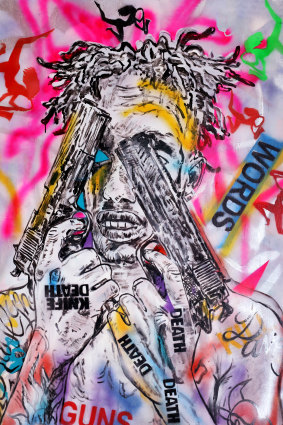
"Words" by George GittoesCredit: George Gittoes
My favourite movie is The Blues Brothers, set in Chicago. As a tribute, I wore a black fedora hat and total black attire, everywhere. One morning, this attire nearly got me killed by cops in our own apartment. Most of the apartments are rigged, by the gangs that have occupied them, to stall a police break-in. Ours, like all others, had iron bars that could be dropped into heavy brackets fixed on either side of the door frames. I never bothered with this, so when a squad of cops were trying to break down our neighbour’s door and couldn’t, they took their frustration out on ours. I was dressed ready to head out, as they burst in pointing guns at my face and heart. They had been startled to see a white man, with black mobster hat and clothes, and assumed something sinister; like I had been sent by the mob to retrieve stolen drugs or do a hit.
Fortunately, a woman sergeant arrived in time to yell at them to, “de-escalate!!!! ”. I got so used to these break-ins that one night I heard cop noise and thought it was from upstairs, so I went back to sleep. Next thing Waqar was banging on my door, yelling, “George are you OK? The police just came out your door.” The cops were outside surrounding our car. I challenged them and one casually yelled back, “Hey, we liked the art that you had on your floor.” That was nice to hear, but the fact was I had not had any art on my floor for a week or more. They could have planted drugs or a gun, and I would be writing this from a jailhouse.
The most important thing, if you are contemplating making a film like White Light, is to have a cool car. Ours was a metallic orange Ford Edge with a hotted-up engine, a sunroof and, most important of all, a great booming sound system. The first thing anyone said, when we pulled up, was, ‘Like your car!’.
Our fire-coloured car features in the police bust you see in our documentary. Solja had been under house arrest for months, with an ankle bracelet restricting him to his apartment. On the day we took him to court, he was given a few extra hours of freedom of movement. We drove him over to May Block to ‘chill’ with his friends. Fixed cameras are everywhere monitoring this notorious haunt of the Black Stones.
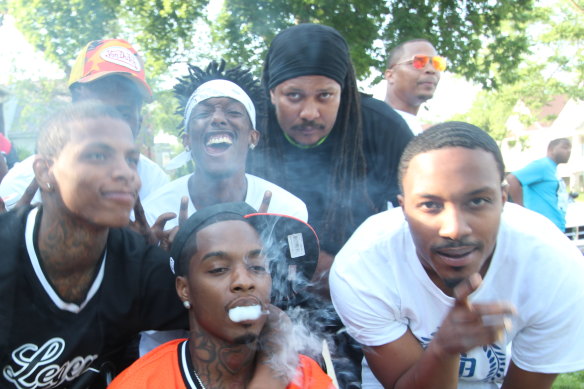
Solja and crew on the Block.Credit: Waqar Alam
The gang calls it ‘the trenches’. A police drone picked up the activity and soon we were surrounded by cop cars. It did not help that there had been three murders in the vicinity that morning. Mac had been to buy dope and was rolling joints for everyone inside the car. As the cops exited their vehicles, Waqar and I were filming the action from the curb.Our guys were brutally cuffed and pushed up against our car while the cops searched every crevice. When more detectives arrived one turned on me saying “Have you been filming illegal activity … smoking marijuana?” and I could see he was itching to find a reason to cuff and charge me.
We were told we needed a permit and forced to switch our cameras off. Solja smiled across to me, letting me know he was secretly filming with his mobile phone camera.
It is all these cameras that make the cops think twice about toning down their aggression. Before cameras in phones, police killings, like that of George Floyd’s being choked in Minneapolis in May, were occurring every day and police were getting away with 100 per cent of them. As the cops drove off, Solja wheeled over to me and said: “That cop whispered in my ear – you know I could have planted a gun on you.” Solja shook his head at a world in which he was supposed to feel grateful for not being set up and said: “The police say we are a gang but they are the worst gang”.
“The police say we are a gang but they are the worst gang”.
Solja, a leader of the Black Stones
I told everyone involved in our film this was their chance to have a voice and let the world hear their story the way they wanted it told. When aggrieved people are not being listened to, they take their anger to the streets. As Pastor Michael Pfleger told us: "95 per cent of the brothers out here in the street want an alternative. It is time to get in the face of America."
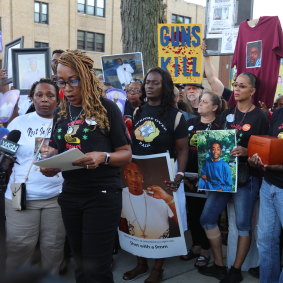
Parents of Child Victims of Gun Violence attend a rally in South Side.Credit: Waqar Alam
Our greatest disappointment was having to tell the community the film had been rejected by the 2019 Chicago Film Festival on the grounds that they had "shown films about coloured people in the past" and did not feel the need to continue. Most of our participants have never been into central upmarket Chicago City and were imagining themselves on the red carpet and had already begun buying evening wear.
When White Light was screened at the Sydney, Melbourne and Brisbane International Film Festivals last year,the group watched a livestream on Solja’s large-screen TV. In October, Smiley (narrator and community leader) and Chantal and Alan Scott (sister and father of murdered Kaylyn) attended the Syracuse International Film Festival on our behalf. In the middle of the night we got a video phone call from their hotel to see the happiest three faces I have ever seen. They all shouted “We have won!” We could not believe it. White Light had won Best Documentary Feature Film and they had been on stage to receive the prize. The next step will be a US wide screening of White Light. As a result of the protests over the George Floyd murder, we have been approached by all the big media players in the US who had previously had the film on a back shelf for assessment.
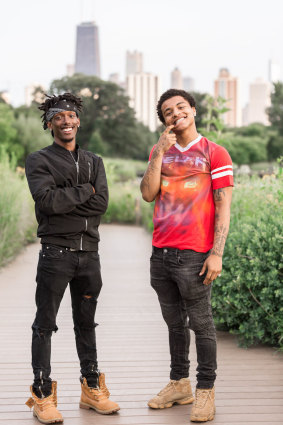
Li'l Dave wants to be a chef, and fellow rapper Li'l Mac a clothing designer.Credit: Chantal Scott
I was in the US in 1968, the year Dr Martin Luther King jnr was assassinated, and it feels the same now. The choking of George Floyd was the tipping point, but the protests will not end until there is real change. In the 12 months we were living on 67th and Rhode, we did not see another white person except for cops. It was hard for me to believe that 50 years had passed since I first became involved in the struggle for social justice in the US, and at every level conditions had got worse for those born black, in American ghettos such as South Side Chicago.
The good news is that everyone in White Light has managed to stay alive and flourish. The young men with Solja at his apartment do not want to be gangsters. Li'l Mac wants to be a clothing designer, so we helped him to get a job designing T-shirts. Li'l Dave wanted to be a chef so we encouraged him to do a course; now he is cooking in a fancy, uptown restaurant. Jon Jon, who was shot with Kaylyn, wants to become a nurse, so we helped get him a hospital job that enables him to study nursing.
Our film ends when Smiley and Li'l Mac walk through red crime-scene tape and snapping it as Smiley says: “This has to go.” The vision then switches to Chicago City where white luxury unrolls before the eyes of Li'l Mac and Li'l Dave, sitting on the deck of a tourist ferry cruise as it passes white people frolicking in the sun and completely oblivious to the suffering hidden away in the black ghettoes.
As soon as travel restrictions ease, we are bringing the core group to visit us at Werri Beach on the south coast of NSW. Hellen and I look forward to seeing them relaxed and not constantly turning their heads from side to side for fear of being shot.
Our intention for White Light was for it to be used as a tool by anti gun violence groups, like Bullets for Lives, to open discussions on how to bring peaceful and positive change. Almost every day, we get positive feedback on successful screenings in community halls around the US.
White Light will screen on ABC TV and iView at 8.30 pm on July 14. Related resources are available at www.gittoes.com.